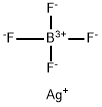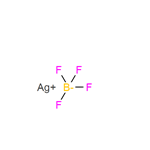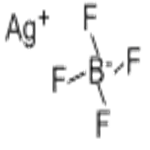Chemical Properties
beige crystalline powder
Uses
Silver tetrafluoroborate finds applications as a useful reagent in inorganic, organic and organomettalic chemistry. It acts as a moderately strong oxidant in dichloromethane, replaces halide anions and ligands with weakly coordinating tetrafluoroborate anions, and behaves as a catalyst for cyclization reactions. It is a potent promoter for chemical glycosylation.
Application
Silver tetrafluoroborate is a transition metal salt extensively used in organic syntheses.
Gold Catalysts — 21st Century ′Gold Rush′
Displaces chloride from precious metal complexes used in the oxidation of alcohols by persulfate.
Provides a silver-ion template for improved macrolatamization of a linear dipeptide.
General Description
Silver tetrafluoroborate (AgBF4) is used as a Lewis acid in organic synthesis. It is known to have a high affinity towards organic halides. It is employed in organic reactions like activation of acyl chlorides, nucleophilic substitution, rearrangement, cycloaddition, cyclization, ring expansion and oxidation.
reaction suitability
reagent type: oxidant
Safety Profile
Poison by intravenous route. When heated to decomposition it emits toxic fumes of F-. Used for plating baths. See also SILVER COMPOUNDS, BORON COMPOUNDS, and FLUORIDES.
Synthesis
Preparation of silver tetrafluoroborate and MBDP
This reaction is completed with the lights off. In a 25 mL round-bottom flask covered with aluminum foil, AgBF4 (0.0397 g (0.20 mmol) is dissolved in 10 mL CH3CN. To the solution MBDP (0.0645 g, 0.20 mmol) is added and allowed to stir for 3 hours. The solution is concentrated under vacuum to approximately 3 mL then layered with Et2O. The flask is placed in the freezer. X-ray quality crystals are formed.





